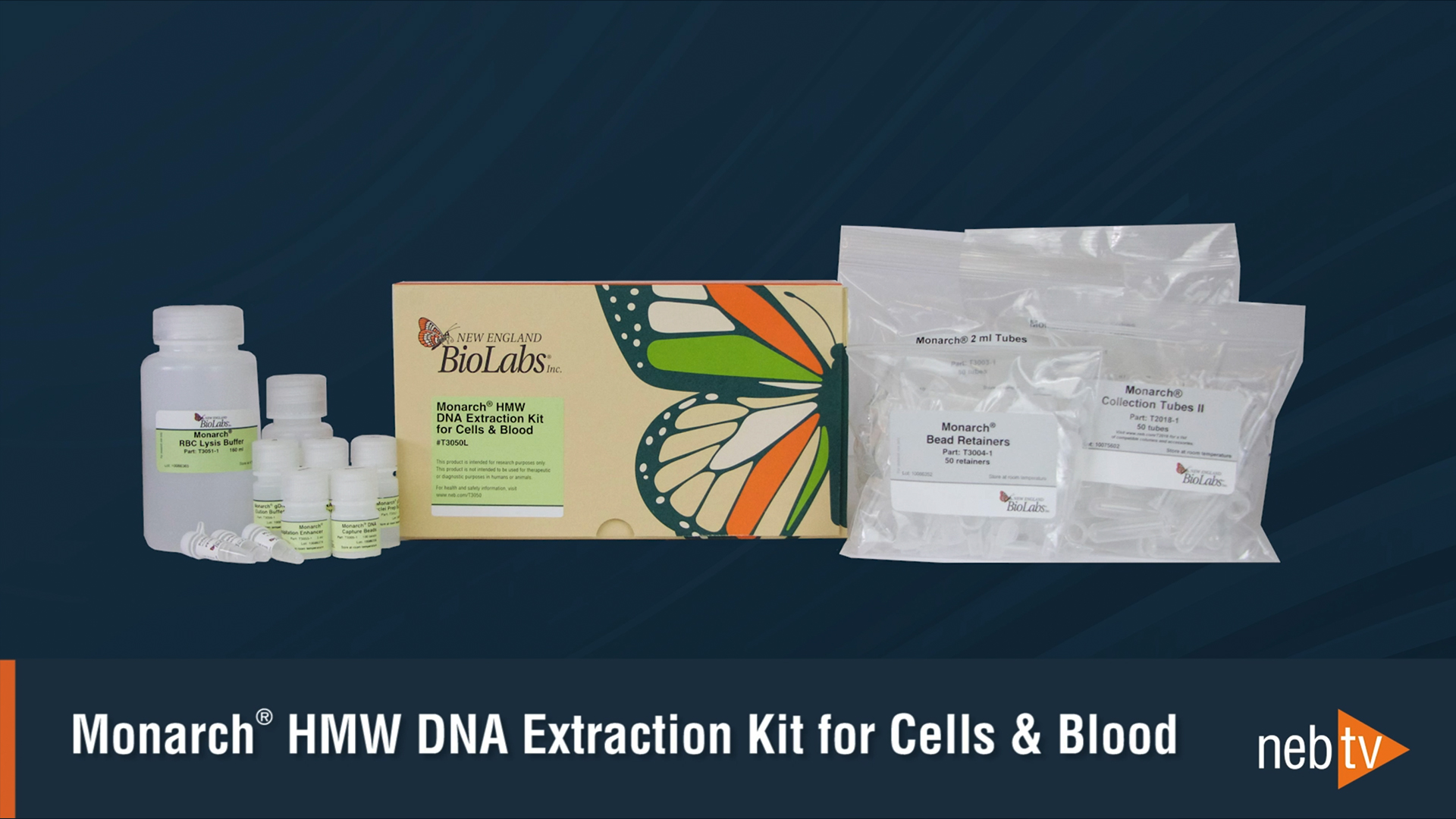Protocol for High Molecular Weight DNA (HMW DNA) Extraction from Blood (NEB #T3050)
Below is a detailed protocol for the extraction of high molecular weight DNA from blood samples. Please refer to the complete product manual for more detailed guidance. For help selecting input amounts, visit Choosing Input Amounts for the Monarch HMW DNA Extraction Kits. If you are using this kit upstream of ultra-long DNA sequencing on the Oxford Nanopores Technologies platform, please also review our Ultra-Long DNA Sequencing Workflow®’ Guidance for HMW DNA Extraction Upstream of Oxford Nanopore Technologies as well as our Protocol for UHMW DNA Cleanup in the Oxford Nanopore Technologies® UL Library Prep Workflow.
Materials Required but Not Supplied:
- Microcentrifuge capable of being set to 4°C. If working with blood aliquots > 500 µl, a centrifuge that accommodates 15 ml tubes will be required. Alternatively, split the sample into aliquots of 0.5 ml to use a microcentrifuge
- Thermal mixer containing a 2 ml tube block (if not available, use a 1.5 ml block).
- Vertical rotating mixer (e.g., Thermo Scientific HulaMixer Sample Mixer) is recommended for all samples and is required for frozen blood.
- Ice or cooling block
- Ethanol (≥ 95%).
- Cold 1X PBS
- Isopropanol, 275 µl per sample (Low Input: 100 µl/sample).
- 1.5 ml DNase-free, low DNA binding microfuge tubes (e.g., Eppendorf® DNA LoBind®, #0030108051) are recommended for elution and storage (1 per sample); it is especially important to use low DNA binding tubes if working with UHMW DNA, which tends to bind to plastic surfaces.
- Recommended: vertical rotating mixer (e.g., Thermo Scientific® HulaMixer® Sample Mixer).
- Wide-bore pipette tips.
Important Notes Before You Begin:
- Review the complete protocol before beginning.
- Add ethanol (≥ 95%) to the gDNA Wash Buffer as indicated on the bottle label.
- Cool the Nuclei Prep Buffer, RBC Lysis Buffer and PBS to 4°C.
- Preheat thermal mixer with 2 ml block to 56°C.
- Proteinase K and RNase A should be stored at -20°C.
![]() Once RBC Lysis Buffer has been added, proceed quickly through the protocol. Extended exposure of leukocytes to this buffer will lead to clumping and reduced DNA yield and quality.
Once RBC Lysis Buffer has been added, proceed quickly through the protocol. Extended exposure of leukocytes to this buffer will lead to clumping and reduced DNA yield and quality.
![]() It is essential to resuspend the cell pellet completely wherever indicated. Leukocyte clumping will lead to
It is essential to resuspend the cell pellet completely wherever indicated. Leukocyte clumping will lead to
difficulty dissolving DNA.
Starting Material Notes:
This protocol has been validated on fresh blood samples (human, mouse, rat, rabbit, horse, cow, pig and monkey) and frozen blood samples (human, mouse, rabbit, horse, cow, pig and monkey). Do not use frozen rat blood samples, as erythrocyte lysis is not effective; consider using a product employing direct lysis of whole blood (e.g., Monarch Genomic DNA Purification Kit (NEB #T3010). See “Important Considerations for Starting Materials” and "Choosing Input Amounts for the Monarch HMW DNA Extraction Kits" or review the product manual, before beginning, specifically if working with rabbit samples.
|
BLOOD SOURCE |
PROTOCOL DESIGNATION |
INPUT AMOUNT |
|---|---|---|
|
Mammalian |
Standard Input |
500 µl–2 ml |
|
Low Input |
100 µl to < 500 µl |
|
|
Nucleated |
Standard Input |
2–20 µl |
* If working with ≥ 500 µl blood, either split sample into 500 µl aliquots or work in a larger tube. If splitting samples into 500 µl aliquots, combine leukocyte pellets into 1.5 ml of RBC Lysis Buffer and transfer to a Monarch 2 ml Tube in Step 4 for further processing.
Important Notes for Fresh Blood
- Fresh samples provide the greatest yield; process blood samples soon after collection
- Leukocyte stability will decline after each day of storage. Cells will become stickier and difficult to resuspend.
- Mix blood sample well by vortexing before starting
Important Notes for Frozen Blood
- Freeze blood in aliquots of the desired volume immediately following collection to maintain integrity of leukocytes
- Sample container needs to accommodate 3 volumes of RBC Lysis Buffer
- Avoid thawing sample before processing, as DNA integrity will be compromised; thaw in the presence of RBC Lysis Buffer, per the protocol
HMW gDNA Purification Consists of Three Stages:
PART 3: HMW gDNA Binding and Elution
PART 1: Erythrocyte Lysis
Fresh Mammalian Blood
- Add up to 500 µl of blood to a Monarch 2 ml Tube and add 3 volumes of cold RBC Lysis Buffer (e.g., 1.5 ml RBC Lysis Buffer for 500 µl blood). Close the cap and invert 3–5 times to mix. If working with rabbit blood, consider using an input volume of 200 µl; however, use 1.5 ml of RBC Lysis buffer instead of 3 volumes.
- Incubate on ice; when sample starts to turn translucent (6–12 minutes for fresh blood, 5–7 minutes for week-old blood), mix by inverting a few times, and then wait an additional 3–5 minutes for the RBC lysis to be complete.
 RBC lysis is stressful for leukocytes; it is important to process samples quickly; extended exposure of leukocytes to RBC Lysis Buffer can lead to clumping, lower yields and reduced solubility of the eluted DNA.
RBC lysis is stressful for leukocytes; it is important to process samples quickly; extended exposure of leukocytes to RBC Lysis Buffer can lead to clumping, lower yields and reduced solubility of the eluted DNA.
- Pellet leukocytes for 3 minutes at 1,000 x g at 4°C, then carefully remove most of the supernatant by pipetting, leaving approximately 15–20 µl behind to avoid disturbing the pellet. Angle the tube, pellet down, and pipette from the upper side of the tube. Pipetting too close to the pellet will reduce DNA yield, as the pellet structure is loose.
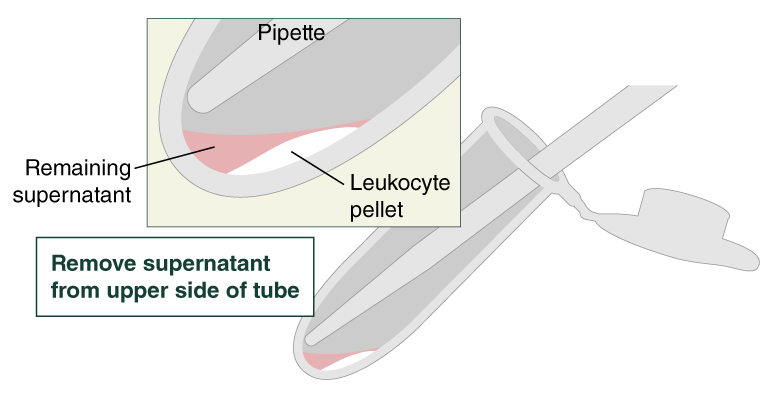
- Flick the tube or drag along a microtube rack to resuspend the pellet. Briefly vortex sample and add 1.5 ml of cold RBC Lysis Buffer. Vortex to resuspend cells completely. Incubate on ice for 3 minutes. Use 1.5 ml for all samples regardless of input amount. If working in a 15 ml tube, move sample to a Monarch 2 ml Tube after resuspension in RBC Lysis Buffer.
 If working with multiple samples, resuspend, vortex, add buffer, vortex again and then move on to the next sample; this prevents clumping of the leukocytes.
If working with multiple samples, resuspend, vortex, add buffer, vortex again and then move on to the next sample; this prevents clumping of the leukocytes.
- Pellet leukocytes for 3 minutes at 1,000 x g at 4°C. Remove supernatant by pipetting, leaving approximately 15–20 µl behind to avoid disturbing the pellet as described in Step 3.
- Flick the tube or drag along a microtube rack to resuspend the pellet. Briefly vortex sample and add 1.5 ml of cold PBS. Vortex to mix. If sample is not in a Monarch 2 ml Tube, transfer at this step.
 If working with multiple samples, resuspend, vortex, add PBS, vortex again and then move on to the next sample; this prevents clumping of the leukocytes.
If working with multiple samples, resuspend, vortex, add PBS, vortex again and then move on to the next sample; this prevents clumping of the leukocytes.

- Pellet leukocytes for 3 minutes at 1,000 x g at 4°C and remove supernatant by pipetting, leaving approximately 15–20 µl behind as described in Step 3. Proceed immediately to Part 2: Leukocyte Lysis. Leukocyte pellets will be off-white and may contain a small residual amount of red blood cells. If pellet still contains a large fraction of red blood cells, repeat Steps 4-7. In the future, increase the incubation time in Steps 2 and 4 by a few minutes to ensure erythrocyte lysis is complete.
Frozen Mammalian Blood
- Add 3 volumes of cold RBC Lysis Buffer, close cap and invert a few times, ensuring that the buffer can move freely within the tube.
- Incubate samples at room temperature for 30–90 seconds in a tube rack, shaking a few times to facilitate thawing, until RBC Lysis Buffer turns more intensely red.
- Place samples in a vertical rotating mixer at ~10 rpm until pellet is thawed and dissolved. Do not exceed 5 minutes. For 500 µl aliquots, thawing is usually complete after ~5 minutes. If after 5 minutes, the sample is not thawed, shake it a few times to facilitate complete thawing. Larger frozen aliquots may take longer to thaw. Remove from rotator as soon as sample is thawed, as extended exposure to warm temperatures will harm the leukocytes.
Samples from some species, including rabbit, will form a very rigid frozen cell pellet that has a significantly higher cell count than other species. Support the thawing process by frequently flicking the tube vigorously to loosen the pellet. This ensures that thawing is complete within 5 minutes.
- After frozen blood has thawed completely, vortex to resuspend any remaining cell aggregates and keep on ice.
- Pellet leukocytes for 3 minutes at 1,000 x g at 4°C, then carefully remove most of the supernatant by pipetting, leaving approximately 15–20 µl behind to avoid disturbing the pellet. Angle the tube, pellet down, and pipette from the upper side of the tube.
Pipetting too close to the pellet will reduce DNA yield, as the pellet structure is loose.
For samples with a low leukocyte content like cow blood or low input samples, there may not be a clearly visible pellet after centrifugation. However, leukocytes are present and spread more evenly along the tube wall. Process samples by removing the supernatant carefully while placing the pipette tip at the opposite side of the tube, to ensure the leukocyte layer is not disturbed.
- Vigorously flick the tube or drag along a microtube rack several times to completely resuspend the pellet. If sample has splashed along the tube walls, pulse spin in a benchtop minicentrifuge. Briefly vortex sample, add 1.5 ml of cold PBS, and vortex to mix. If necessary, repeat vortexing to resuspend cells completely. If sample is not in a Monarch 2 ml Tube, transfer at this step.
 If working with multiple samples: resuspend, vortex, add PBS, vortex again, and then move on to the next sample; this prevents clumping of the leukocytes.
If working with multiple samples: resuspend, vortex, add PBS, vortex again, and then move on to the next sample; this prevents clumping of the leukocytes.

- Pellet leukocytes for 3 minutes at 1,000 x g at 4°C, then remove supernatant by pipetting, leaving approximately 15–20 µl behind as described in Step 5. Proceed immediately to Part 2: Leukocyte Lysis. If working with rabbit blood, repeat the PBS wash to reduce hemoglobin content.
Fresh Nucleated Blood
- Add 2–20 µl (5–10 µl is recommended) of blood to a Monarch 2 ml Tube and add 1.5 ml cold RBC Lysis Buffer. Close the cap and invert 3–5 times to mix.
- Incubate on ice for 10 minutes; mix a few times by inverting during the incubation. Sample will turn slightly translucent, but in contrast to non-nucleated blood, will not show a complete change from turbid to translucent.
 RBC lysis is stressful for leukocytes; it is important to process samples quickly; extended exposure of leukocytes to RBC Lysis Buffer can lead to clumping, lower yields and reduced solubility of the eluted DNA.
RBC lysis is stressful for leukocytes; it is important to process samples quickly; extended exposure of leukocytes to RBC Lysis Buffer can lead to clumping, lower yields and reduced solubility of the eluted DNA.
- Pellet leukocytes for 3 minutes at 1,000 x g at 4°C, then remove most of the supernatant by pipetting; leave approximately 15–20 µl behind to avoid disturbing the pellet. Angle the tube, pellet down, and pipette from the upper side of the tube.
Pipetting too close to the pellet will reduce DNA yield, as the pellet structure is loose.
- Flick the tube or drag along a microtube rack to resuspend the pellet. Briefly vortex sample and add 1.5 ml of cold RBC Lysis Buffer. Vortex to resuspend cells completely and incubate on ice for 3 minutes. Use 1.5 ml for all samples regardless of input amount. If working in a 15 ml tube, move sample to a Monarch 2 ml Tube after resuspension in RBC Lysis Buffer.
 If working with multiple samples, resuspend, vortex, add buffer, vortex again and then move on to the next sample;
this prevents clumping of the leukocytes.
If working with multiple samples, resuspend, vortex, add buffer, vortex again and then move on to the next sample;
this prevents clumping of the leukocytes.

- Pellet leukocytes for 3 minutes at 1,000 x g at 4°C. Remove supernatant by pipetting, leaving approximately 15–20 µl behind to avoid disturbing the pellet as described in Step 3.
- Flick the tube or drag along a microtube rack to resuspend the pellet. Briefly vortex sample and add 1.5 ml of cold PBS. Vortex to mix. If sample is not in a Monarch 2 ml Tube, transfer at this step.

 If working with multiple samples, resuspend, vortex, add PBS, vortex again and then move on to the next sample;
this prevents clumping of the leukocytes.
If working with multiple samples, resuspend, vortex, add PBS, vortex again and then move on to the next sample;
this prevents clumping of the leukocytes.
- Pellet leukocytes for 3 minutes at 1,000 x g at 4°C and remove supernatant by pipetting, leaving approximately 15–20 µl as described in Step 3. Proceed immediately to Part 2: Leukocyte Lysis. Leukocyte pellets will be off-white and may contain a small residual amount of red blood cells. If pellet still contains a large fraction of red blood cells, repeat Steps 4–7. In the future, increase the incubation time in Steps 2 and 4 by a few minutes to ensure erythrocyte lysis is complete.
Frozen Nucleated Blood
Before beginning, review the "Important Notes” relating to frozen blood samples. There are essential considerations that directly impact performance of the prep and the integrity of the DNA.- Add 1.5 ml of cold RBC Lysis Buffer. Invert a few times until the blood starts to thaw. RBC Lysis Buffer will begin to turn red.
- Incubate samples on ice 2–3 minutes, flicking periodically to facilitate thawing and resuspension.
- After thawing is complete, vortex briefly to dissolve any cell aggregates.
- Pellet leukocytes for 3 minutes at 1,000 x g at 4°C, then remove most of the supernatant by pipetting, leaving approximately 15–20 µl behind to avoid disturbing the pellet. Angle the tube, pellet down, and pipette from the upper side of the tube.
Pipetting too close to the pellet will reduce DNA yield, as the pellet structure is loose.
- Flick the tube or drag along a microtube rack to completely resuspend the pellet. If sample has splashed along the tube walls, pulse spin in a benchtop minicentrifuge. Briefly vortex sample, add 1.5 ml of cold PBS, and vortex to mix. If necessary, repeat vortexing to resuspend cells completely. If sample is not in a Monarch 2 ml Tube, transfer at this step.
If working with multiple samples: resuspend, vortex, add PBS, vortex again, and then move on to the next sample;
this prevents clumping of the leukocytes. - Pellet leukocytes for 3 minutes at 1,000 x g at 4°C and remove supernatant by pipetting, leaving approximately 15–20 µl behind as described in Step 4. Proceed immediately to Part 2: Leukocyte Lysis.
PART 2: Leukocyte Lysis
- Prepare Nuclei Prep and Lysis Solutions as indicated below:
a. Nuclei Prep Solution: Combine cold Nuclei Prep Buffer and RNase A according to the table below and vortex to mix. Keep on ice.STANDARD INPUT
LOW INPUT
# of SAMPLES
VOLUME OF NUCLEI PREP BUFFER (µl)
VOLUME OF RNase A (µl)
VOLUME OF NUCLEI PREP BUFFER (µl)
VOLUME OF RNase A (µl)
1
165
5.5
55
2
2
330
11
110
4
3
495
16.5
165
6
4
660
22
220
8
5
825
27.5
275
10
b. Nuclei Lysis Solution: Combine Nuclei Lysis Buffer and Proteinase K according to the table below and vortex to mix. Keep at room temperature.STANDARD INPUT
LOW INPUT
# of SAMPLES
VOLUME OF NUCLEI LYSIS BUFFER (µl)
VOLUME OF PROTEINASE K (µl)
VOLUME OF NUCLEI LYSIS BUFFER (µl)
VOLUME OF PROTEINASE K (µl)
1
165
11
55
4
2
330
22
110
8
3
495
33
165
12
4
660
44
220
16
5
825
55
275
20
- Proceed with steps A-C for each sample before moving on to the next sample. Avoid introducing air bubbles when pipetting and mixing.
- Flick the tube or drag along a microtube rack to resuspend cell pellet completely. If sample has splashed along the tube walls, pulse spin in a benchtop minicentrifuge.
- Add 150 µl (Low Input: 50 µl) of Nuclei Prep Solution and pipette up and down 10 times (20 times for frozen samples) to mix. The sample will become less turbid, indicating cell lysis; nuclei remain intact. Nuclei from frozen blood and from fresh blood that has been stored for several days may contain clumps. Pressing the pipette tip to the bottom of the tube during pipetting facilitates complete resuspension.
- Add 150 µl (Low Input: 50 µl) of Nuclei Lysis Solution to sample and invert 10 times to mix. Do not vortex or pipette. Repeat A-C with any remaining samples, leaving finished samples at room temperature.
- Flick the tube or drag along a microtube rack to resuspend cell pellet completely. If sample has splashed along the tube walls, pulse spin in a benchtop minicentrifuge.
- Incubate at 56°C for 10 minutes in a thermal mixer with agitation at the desired speed to control the shearing and tune the size of gDNA. The speed of the thermal mixer influences fragment length; higher speeds reduce overall size. For the standard ligation-based Oxford Nanopore Technologies (ONT) sequencing protocol, agitation at 2,000 rpm is recommended. At 300 rpm, or with no shaking, maximal fragment length, in the Mb range, will be obtained (UHMW DNA). These samples will be highly viscous and difficult to process. Optimization may be required depending on the quality of the starting sample. Refer to “Choosing Agitation Speed During Lysis” for guidance. If desired, samples can be stored at 4°C overnight after the incubation.
- If working with multiple samples, prepare and label the plastics for Part 3: HMW gDNA Binding and Elution. Each sample will require:
- 1 Monarch Collection Tube II (no need to label).
- 1 Monarch Bead Retainer inserted into the collection tube; this will be used to remove the wash buffer from the gDNA bound to the beads.
- 1 Monarch 2 ml Tube; this will be used for eluting the gDNA from the beads.
- 1 1.5 ml microfuge tube (DNA low bind is recommended, not provided); this will be used to collect the eluate.
- Add 75 µl (Low Input: 25 µl) of Precipitation Enhancer after the 10-minute incubation and mix by inverting 8–10 times.
PART 3: HMW gDNA Binding and Elution
- Using clean forceps, add 2 DNA Capture Beads to each sample, which should be contained in a Monarch 2 ml Tube.
- Add 275 µl (Low Input: 100 µl) isopropanol, close the cap, and mix on a vertical rotating mixer at 10 rpm for 4 minutes to attach DNA to the beads. When working with ≥ 1 ml blood, double the inversion time to 8 minutes; this is especially important if low agitation speeds were used during lysis.
If a vertical rotating mixer is not available, invert slowly and gently by hand 30 times. A manual inversion is complete when the tube returns to the upright position. Slow inversion is critical for the DNA to bind to the beads; each full inversion should take ~5–6 seconds. If necessary, flick the tube to release any beads that stick to the bottom of the tube.
After a few inversions, the solution becomes more viscous and the DNA will wrap loosely around the beads. During the following inversions, precipitation of gDNA may be visible, especially with sample inputs ≥ 500 µl. The DNA complex will often contain small air bubbles. With more inversions, the DNA will completely wrap around the beads, often causing the beads to stick together.
- Remove and discard liquid by pipetting. Avoid removing any of the gDNA wrapped around the glass beads. For optimal DNA solubility, avoid letting the bound DNA dry out on the beads during this and the following steps; add the next buffer quickly. There are two suggested options for carrying out this step:
- Keeping tube upright, insert pipette tip and gently push beads aside to remove liquid.
- Angle the tube so that beads remain at the bottom, and liquid reaches toward tube opening. Pipette from the liquid surface and continue to angle as liquid is removed (tube will be almost horizontal at the end).
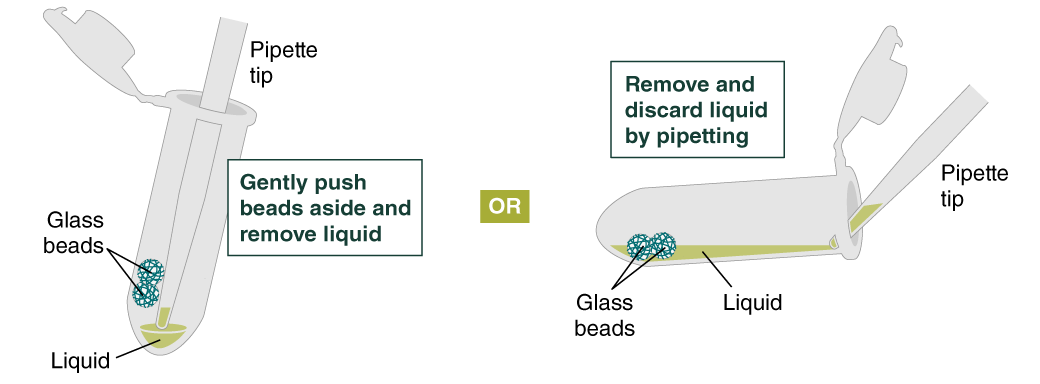
- Keeping tube upright, insert pipette tip and gently push beads aside to remove liquid.
- Add 500 µl gDNA Wash Buffer, close the cap, and mix by inverting the tube 2–3 times. Remove the gDNA Wash Buffer as described in step 3. The loose gDNA complex will condense around the beads more tightly.
- Repeat the wash in Step 4. Remove the gDNA Wash Buffer by pipetting. Alternatively, the buffer can be removed by decanting: position a pipette tip at the top of the angled tube to prevent the beads from falling out. It is not necessary to remove all the gDNA Wash Buffer at this point.
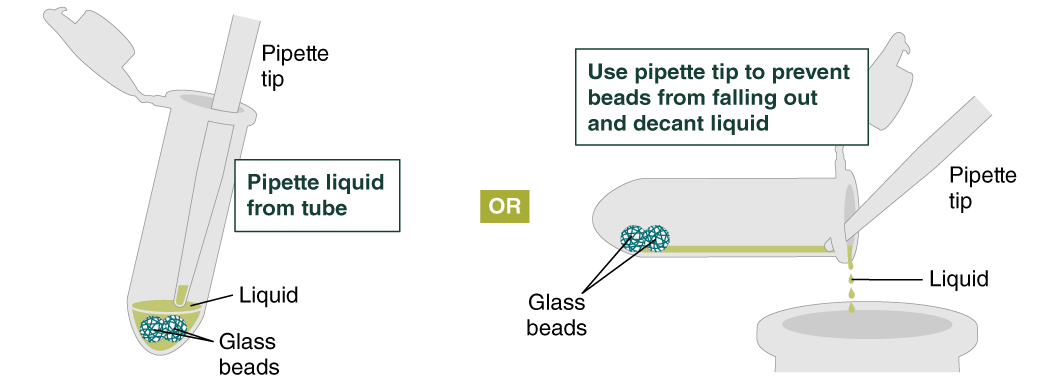
- Place a labeled bead retainer into a Monarch Collection Tube II. Pour the beads into the bead retainer and close the cap. Discard the used Monarch 2 ml Tube. When working with multiple samples, be sure to close the cap of the bead retainer after each transfer of beads.
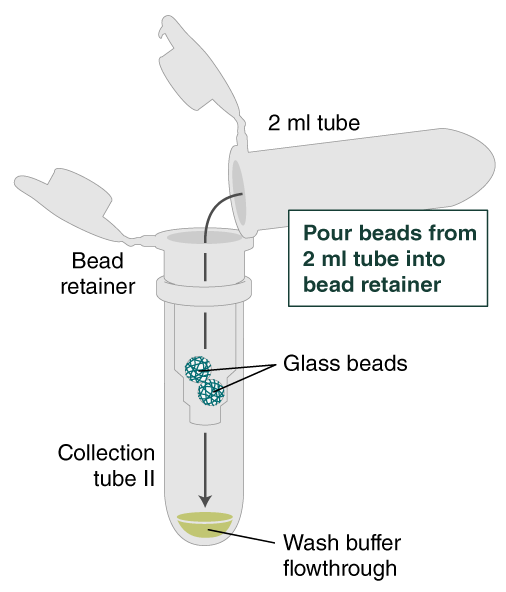
- Pulse spin (1 second or less) the sample in a benchtop minicentrifuge to remove any residual wash buffer from the beads.
- Separate the bead retainer from the collection tube, pour the beads into a new, labeled Monarch 2 ml Tube, and insert the used bead retainer into the labeled 1.5 ml microfuge tube (DNA low bind recommended, not provided) for later use during elution. Discard the used collection tube.
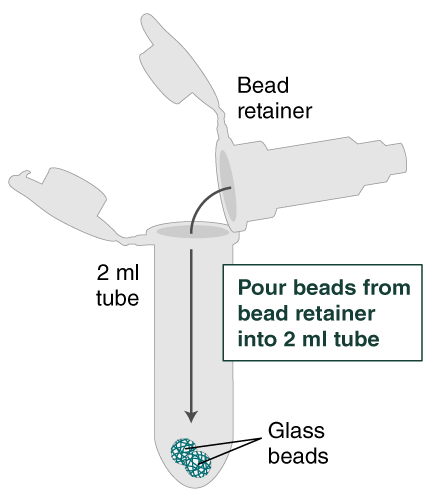
- Immediately add 100 µl (200 μl if working with ≥ 1 ml of blood or with ≥ 10 µl of nucleated blood) Elution Buffer II onto the glass beads and incubate for 5 minutes at 56°C in a thermal mixer with agitation at the lowest speed (300 rpm). Halfway through the incubation, ensure the beads are not stuck to the bottom of the tube by tilting the tube almost horizontally and gently shaking; do not let the liquid reach the cap. This ensures that the beads can move freely, allowing for optimal release of the DNA from the beads. It also ensures that the lower bead does not stick to the bottom of the tube during the following transfer step. Elution volume can be reduced to as low as 50 μl without affecting recovery. However, if using < 100 μl, the gentle shaking of the sample should be done several times during the incubation to ensure complete wetting of the beads.
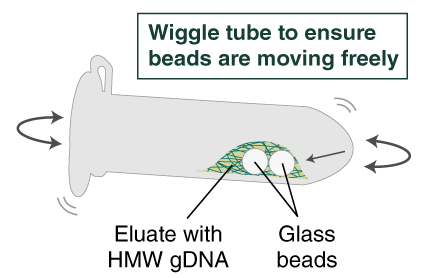
- Ensure the bead retainer is inserted into the 1.5 ml microfuge tube. Pour the eluate and the glass beads into the bead retainer and close the cap. When working with more than 1 sample, it is important to close the cap after each transfer of beads. Typically, all the eluate flows into the bead retainer upon pouring. If any volume remains in the 2 ml tube, spin briefly and transfer.
- Centrifuge for 30 seconds (1 minute if working with ≥ 1 ml blood) at 12,000 x g to separate the eluate from the glass beads. Discard the beads and retainer.
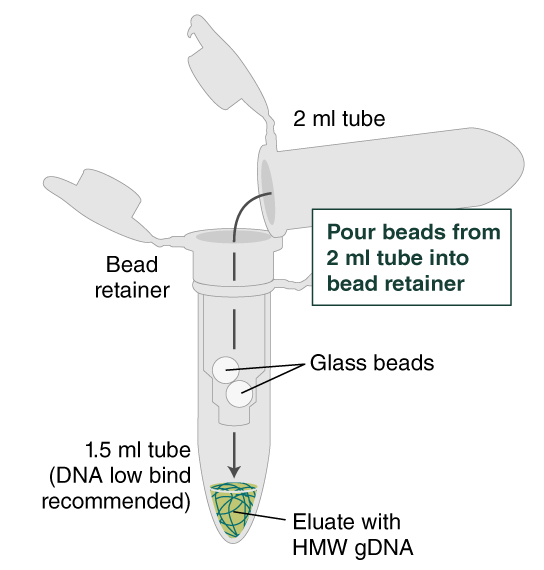
- Pipette eluate up and down 5–10 times with a wide bore pipette tip and ensure any visible DNA aggregates are dispersed. Before analysis or downstream use, HMW DNA must be homogeneously dissolved. After pipetting, incubate at 37°C for 30-60 minutes, overnight at room temperature, or for > 24 hours at 4°C. Pipette up and down 5-10 times again before analyzing or using the HMW DNA. Samples processed using low agitation speeds during lysis will require additional time to fully dissolve. See additional guidance in “Homogenization of HMW DNA Samples”. Samples can be stored at 4°C for short term use (weeks), or at -20°C for long term storage. The elution buffer (10 mM Tris, pH 9.0, 0.5 mM EDTA) is formulated for long term storage of gDNA.

